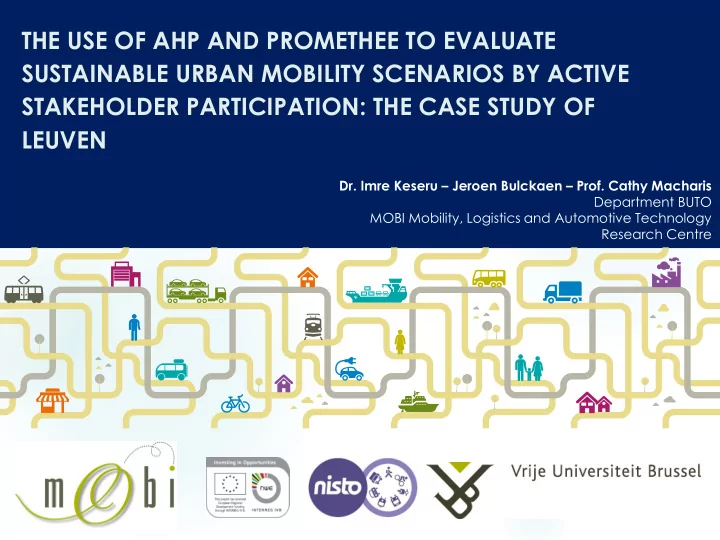

THE USE OF AHP AND PROMETHEE TO EVALUATE SUSTAINABLE URBAN MOBILITY SCENARIOS BY ACTIVE STAKEHOLDER PARTICIPATION: THE CASE STUDY OF LEUVEN Dr. Imre Keseru – Jeroen Bulckaen – Prof. Cathy Macharis Department BUTO MOBI Mobility, Logistics and Automotive Technology Research Centre
Who is in charge of planning? www.globalnerdy.com/2009/08/10/old-ibm-ad-150-extra-engineers/
The new “ players ”
Diverse objectives of stakeholders
NISTO project New integrated smart transport options Development of an evaluation framework and toolkit More information: www.nisto-project.eu
Research questions Is the multi-actor multi-criteria analysis (MAMCA) a suitable tool for decision making for sustainable urban mobility? How can electronic GDSS make MAMCA more resource efficient while involving a high number of stakeholders?
Methodology: multi-actor multi-criteria analysis (Macharis et al. , 2004)
Methodology: Computer support for MAMCA (Macharis et al. , 2004)
Methodology: AHP and PROMETHEE HEE AHP PROMET METHEE
Methodology: AHP and PROMETHEE Evaluation - PROMETHEE Weight elicitation – AHP Avoids trade-offs Easy to use between scores It can decompose a complex problem into Simplifies the its constituents evaluation procedure Widely used for weight elicitation Based on Macharis et. al 2003
Case study: MAMCA GDSS workshop Leuven, 30 th January 2014 40 participants 7 stakeholder groups 14 subgroups Software: D-Sight Web
Problem
Alternatives Business as usual Car-free city centre Park and Walk Smart road user charging
Stakeholder criteria and weights
Weight elicitation: AHP Source: D-Sight Web
Evaluation of alternatives: PROMETHEE Source: D-Sight Web
Results: multi-actor view 100 90 80 70 Performance score 60 50 40 30 20 10 0 Flemish City council Citizens PT users Car users PT operators Retail and Government Leuven employers Business as usual Car free city centre Park & Walk Smart road user charging
Results: Criteria contribution (Flemish government) 80 70 16.3 60 9.4 Environment Performance score 50 26.3 Traffic safety 13.2 40 5.5 Accessibility Efficient public 30 13.2 10.3 spending 18.9 1.3 Equity 3.2 20 3.4 8.7 6.8 6.8 10 20.0 16.8 11.8 8.1 0 Smart road user Park & Walk Car free city Business as usual charging centre (Source: adapted from D-Sight Web)
Conclusions 1 MAMCA provides a structured way to appraise the preferences of stakeholders for urban mobility The interactive evaluation with the combination of AHP and PROMETHEE was well received by the participants The combination of a workshop setting and the online software can help to improve understanding and conflict resolution The EGDSS assisted MAMCA is more resource efficient
Conclusions 2 The real-time analysis of multiple decision trees requires computer support The software was not ideally suited for the MAMCA workshop (only single value trees are supported) Further research: software based on the specific requirements of MAMCA
Thank you for your attention! dr. Imre Keseru Vrije Universiteit Brussel Imre.Keseru@vub.ac.be Vrije Universiteit Brussel Jeroen Bulckaen Vrije Universiteit Brussel Jeroen.Bulckaen@vub.ac.be Prof. dr. Cathy Macharis Vrije Universiteit Brussel www.nisto-project.eu Cathy.Macharis@vub.ac.be Pag. Author
Recommend
More recommend